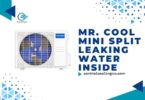Introduction:
Facing a furnace that refuses to kick in can be immensely frustrating, particularly when temperatures drop. Numerous factors could contribute to this malfunction. In this guide, we’ll delve into common issues and offer potential solutions to help you rectify the situation.
1. Thermostat Concerns:
– Incorrect Thermostat Settings:
Before assuming a faulty thermostat, verify if settings are accurate. Ensure it’s on “heat” mode and set to a temperature higher than the room’s current reading. Additionally, check the fan setting—set it to “auto” to prevent continuous fan operation.
– Dead Batteries:
Many thermostats rely on batteries. If they’re dead, the thermostat might not function properly. Look for a low battery indicator or replace batteries annually to avoid unexpected malfunctions.
– Loose or Corroded Wiring:
Inspect wiring connections if settings are correct and batteries fresh. Over time, wiring can loosen or corrode, disrupting the connection between thermostat and furnace. Tighten loose connections and clean corrosion gently with a wire brush or seek professional assistance.
– Faulty Thermostat Sensor:
Thermostats use sensors to detect room temperature accurately. A dirty or faulty sensor may cause inaccuracies, leading to furnace malfunction. Clean the sensor with a soft cloth, and if the issue persists, consider replacing it or contacting a professional.
– Thermostat Location:
Improper thermostat placement, near heat sources like vents or direct sunlight, can affect functionality. Ensure it’s centrally located, away from drafts or heat sources, for accurate temperature measurement and furnace control.
– Compatibility Issues:
Mismatched compatibility between furnace and thermostat, especially with upgrades, can lead to operational issues. Check documentation or consult a professional for compatibility verification.
2. Electrical Problems:
– Circuit Breaker Inspection:
Start with the circuit breaker panel. Look for tripped breakers and reset them if necessary to restore power to the furnace.
– Fuse Inspection:
Inspect furnace fuses for any blown ones. Replace them if needed with fuses of the same amperage. Immediate fuse blowouts indicate deeper electrical issues, necessitating professional intervention.
– Wiring Checks:
Faulty or damaged wiring can hinder furnace operation. Visually inspect wiring connections for damage or looseness. Replace damaged wires and seek professional assistance if unsure.
3. Pilot Light and Ignition System:
– Pilot Light Issues:
Ensure the pilot light is lit and follows manufacturer instructions if relighting is necessary. If it repeatedly extinguishes, a faulty thermocouple might be the cause, requiring professional replacement.
– Ignition System Problems:
For electronic ignition systems, check if the igniter functions correctly. Clean or replace it if needed. Ensure proper alignment and cleanliness for direct spark ignition systems to avoid ignition failures.
4. Airflow Issues:
– Clogged Air Filters:
Regularly replace dirty air filters to prevent airflow obstruction, overheating, and subsequent furnace failure.
– Blocked Vents and Registers:
Clear obstructions from vents and registers to maintain adequate airflow, crucial for efficient furnace operation.
– Ductwork Problems:
Inspect ductwork for leaks, gaps, or disconnections. Seal any found leaks to prevent air loss and ensure proper airflow to the furnace.
– Blower Motor Troubles:
Check if the blower motor runs when the furnace is on. If not, seek professional assistance to diagnose and repair motor or capacitor issues.
5. Gas Supply Issues:
– Gas Valve:
Ensure the gas valve is fully open to allow proper gas flow. Seek professional help if the issue persists.
– Gas Line Leaks:
Address suspected gas leaks immediately by evacuating the premises and contacting professionals for assistance.
– Gas Pressure:
Inadequate gas pressure can hinder ignition. Consult professionals to adjust gas pressure if needed.
– Gas Shut-Off Valve:
Ensure the gas shut-off valve is in the “on” position. Contact professionals if the issue persists.
6. Safety Controls:
– Flame Sensor:
Clean the flame sensor to ensure proper operation. Replace if necessary.
– Limit Switch:
Check and repair or replace a faulty limit switch to prevent overheating issues.
– Pressure Switch:
Ensure proper airflow and troubleshoot pressure switch issues to maintain furnace functionality.
– Rollout Switch:
Reset the rollout switch and identify and address underlying causes to prevent hazardous situations.
– Ignition Control Module:
Replace a faulty ignition control module to ensure proper ignition sequence.
7. Mechanical Components
– Blower Motor:
Ensure the blower motor receives power and seek professional help if it fails to start.
– Capacitor:
Replace a faulty capacitor to ensure proper blower motor function.
– Heat Exchanger:
Inspect for cracks or damage and seek professional assistance for repair or replacement.
8. Schedule Regular Maintenance:
Arrange annual maintenance checks with HVAC professionals to prevent unexpected breakdowns and ensure furnace efficiency and reliability.
Conclusion:
In the face of a malfunctioning furnace, navigating through the troubleshooting process can be a challenging endeavor. If any uncertainty arises or if the troubleshooting steps prove ineffective, seeking professional assistance is strongly advised to ensure the furnace’s safe and efficient operation. Moreover, incorporating regular maintenance checks by HVAC professionals into one’s schedule can significantly mitigate the risk of unexpected breakdowns, prolong the furnace’s lifespan, and maintain optimal efficiency, providing homeowners with peace of mind during the cold seasons. By adhering to these guidelines and being proactive in furnace maintenance, homeowners can minimize inconvenience and ensure their homes remain comfortably heated when temperatures plummet.
Disclosure: We may get commissions for purchases made through links in this post.








